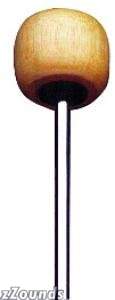When composing for percussion, it is important to know the difference between a variety of mallets. Although in most cases the percussionist will choose the proper mallets for the passage, sometimes as a composer, you want a particular sound. It is always good to research a mallet before indicating it in your score. Consult a percussion catalogue for a more in-depth look at the hundreds of mallets available.
1. YARN MALLETS
They come in every dynamic range from supersoft baseball-sized to forte. They are the multi-purpose mallet, used for toms, suspended cymbal rolls, marimba, xylophone, woodblock, and pretty much anytime a percussionist doesn't have time to pick up another mallet.

2. CORD MALLETS
These are harder than the yarn mallets. More effective on xylophone and vibes, these mallets can also be used for a variety of percussion instruments.

3. BRASS MALLETS
These are for use on the glockenspiel/bells and the occasional brake drum. They produce a more "tinny" kind of sound and pretty much kill the ears of any percussionist using them, as well as the unlucky French Horn player sitting right in front of the glockenspiel.

4. WOODEN MALLETS
Large ones are often used for bass drum playing. There are also varieties for the timpani and mallet instruments. I find wooden mallets dull on the xylophone and bells. Also, wooden mallets cannot be used on vibes or marimbas.

5. CARTWHEEL TIMPANI MALLETS
Differing in shape from other mallets, the use of a cartwheel timpani mallet is often up to the discretion of the timpanist.

6. SYNTHETIC MALLETS (nylon, acetyl, etc.)
Great for Xylophone and Bells, there are a great variety of plastics out there for forte mallet passages. These are not to be used on vibes or marimbas.

7. GONG MALLETS
True gong and tam-tam mallets resemble large wound yarn marimba mallets. A way to make a cheap one is by mounting a hockey puck on a large stick and proceeding to wrap it with yarn. Many composers make the mistake of thinking that a bass drum beater sounds the same on a gong. Wrong. That's like saying an oboe's mouthpiece works fine on a clarinet.

8. BASS DRUM BEATERS
Bass drum beaters are almost egg-shaped and are made to coax the fullest sound from a large head. They are ineffective on any other instrument because of their design.

9. DUAL-PURPOSE MALLETS
These mallets help out the percussionist by doubling up a mallets utility. For instance, one end may be a yarn mallet and the other is a drumstick. There are dozens of varieties available, even a dual timpani mallet/maraca for the lick in Bernstein's West Side Story. Leave it up to the percussionist to use these mallets, as they are difficult in technically challenging passages.

10. BRUSHES
They can be wire, plastic, or even made out of twigs. In jazz they produce those light swishes on the snare. In percussion ensemble pieces, they are great for quiet passages. The Hot Rod is a great combo of drumstick and brush that almost every percussion owns.

11. CHIME MALLETS
Shaped like hammers, these mallets are difficult to manage for quick passages but are great for piercing notes. They are made of a variety of materials, from wood to rubber.

12. RUBBER MALLETS
Often used for quieter xylophone passages or just practicing. Practically inaudible on the bells. Sometimes even used for chime parts, but rarely.

1. YARN MALLETS
They come in every dynamic range from supersoft baseball-sized to forte. They are the multi-purpose mallet, used for toms, suspended cymbal rolls, marimba, xylophone, woodblock, and pretty much anytime a percussionist doesn't have time to pick up another mallet.

2. CORD MALLETS
These are harder than the yarn mallets. More effective on xylophone and vibes, these mallets can also be used for a variety of percussion instruments.

3. BRASS MALLETS
These are for use on the glockenspiel/bells and the occasional brake drum. They produce a more "tinny" kind of sound and pretty much kill the ears of any percussionist using them, as well as the unlucky French Horn player sitting right in front of the glockenspiel.

4. WOODEN MALLETS
Large ones are often used for bass drum playing. There are also varieties for the timpani and mallet instruments. I find wooden mallets dull on the xylophone and bells. Also, wooden mallets cannot be used on vibes or marimbas.

5. CARTWHEEL TIMPANI MALLETS
Differing in shape from other mallets, the use of a cartwheel timpani mallet is often up to the discretion of the timpanist.

6. SYNTHETIC MALLETS (nylon, acetyl, etc.)
Great for Xylophone and Bells, there are a great variety of plastics out there for forte mallet passages. These are not to be used on vibes or marimbas.

7. GONG MALLETS
True gong and tam-tam mallets resemble large wound yarn marimba mallets. A way to make a cheap one is by mounting a hockey puck on a large stick and proceeding to wrap it with yarn. Many composers make the mistake of thinking that a bass drum beater sounds the same on a gong. Wrong. That's like saying an oboe's mouthpiece works fine on a clarinet.

8. BASS DRUM BEATERS
Bass drum beaters are almost egg-shaped and are made to coax the fullest sound from a large head. They are ineffective on any other instrument because of their design.

9. DUAL-PURPOSE MALLETS
These mallets help out the percussionist by doubling up a mallets utility. For instance, one end may be a yarn mallet and the other is a drumstick. There are dozens of varieties available, even a dual timpani mallet/maraca for the lick in Bernstein's West Side Story. Leave it up to the percussionist to use these mallets, as they are difficult in technically challenging passages.

10. BRUSHES
They can be wire, plastic, or even made out of twigs. In jazz they produce those light swishes on the snare. In percussion ensemble pieces, they are great for quiet passages. The Hot Rod is a great combo of drumstick and brush that almost every percussion owns.

11. CHIME MALLETS
Shaped like hammers, these mallets are difficult to manage for quick passages but are great for piercing notes. They are made of a variety of materials, from wood to rubber.

12. RUBBER MALLETS
Often used for quieter xylophone passages or just practicing. Practically inaudible on the bells. Sometimes even used for chime parts, but rarely.



Comments